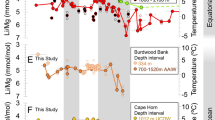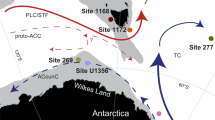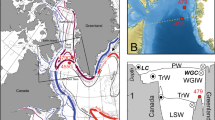Abstract
In the Arctic Ocean, the cold and relatively fresh water beneath the sea ice is separated from the underlying warmer and saltier Atlantic Layer by a halocline. Ongoing sea ice loss and warming in the Arctic Ocean1,2,3,4,5,6,7 have demonstrated the instability of the halocline, with implications for further sea ice loss. The stability of the halocline through past climate variations8,9,10 is unclear. Here we estimate intermediate water temperatures over the past 50,000 years from the Mg/Ca and Sr/Ca values of ostracods from 31 Arctic sediment cores. From about 50 to 11 kyr ago, the central Arctic Basin from 1,000 to 2,500 m was occupied by a water mass we call Glacial Arctic Intermediate Water. This water mass was 1–2 °C warmer than modern Arctic Intermediate Water, with temperatures peaking during or just before millennial-scale Heinrich cold events and the Younger Dryas cold interval. We use numerical modelling to show that the intermediate depth warming could result from the expected decrease in the flux of fresh water to the Arctic Ocean during glacial conditions, which would cause the halocline to deepen and push the warm Atlantic Layer into intermediate depths. Although not modelled, the reduced formation of cold, deep waters due to the exposure of the Arctic continental shelf could also contribute to the intermediate depth warming.
This is a preview of subscription content, access via your institution
Access options
Subscribe to this journal
Receive 12 print issues and online access
$259.00 per year
only $21.58 per issue
Buy this article
- Purchase on Springer Link
- Instant access to full article PDF
Prices may be subject to local taxes which are calculated during checkout



Similar content being viewed by others
References
Stroeve, J., Holland, M. M., Meier, W., Scambos, T. & Serreze, M. Arctic sea ice decline: Faster than forecast. Geophys. Res. Lett. 34, L09501 (2007).
Maslanik, J. A. et al. A younger, thinner Arctic ice cover: Increased potential for rapid, extensive sea-ice loss. Geophys. Res. Lett. 34, L24501 (2007).
Polyakov, I. V. et al. Fate of early 2000s Arctic warm water pulse. Bull. Amer. Meteor. Soc. 92, 561–566 (2011).
Wang, M. & Overland, J. E. A sea ice free summer Arctic within 30 years? Geophys. Res. Lett 36, L07502 (2009).
Arrigo, K. R., van Dijken, G. & Pabi, S. Impact of a shrinking Arctic ice cover on marine primary production. Geophys. Res. Lett. 35, L19603 (2008).
Bates, N. R. & Mathis, J. T. The Arctic Ocean marine carbon cycle: Evaluation of air–sea CO2 exchanges, ocean acidification impacts and potential feedbacks. Biogeosciences 6, 2433–2459 (2009).
Grebmeier, J. M. et al. A major ecosystem shift in the northern Bering Sea. Science 311, 1461–1464 (2006).
Kaufman, D. S. et al. Recent Warming Reverses Long-Term Arctic Cooling. Science 325, 1236–1239 (2009).
Moran, K. et al. The Cenozoic palaeoenvironment of the Arctic Ocean. Nature 441, 601–605 (2006).
Polyak, L. et al. History of sea ice in the Arctic. Quat. Sci. Rev. 29, 1757–1778 (2010).
Karcher, M. J. & Oberhuber, J. M. Pathways and modification of the upper and intermediate waters of the Arctic Ocean. J. Geophys. Res. 107, 3049 (2002).
Rudels, B., Jones, E. P., Schauer, U. & Eriksson, P. Atlantic sources of the Arctic Ocean surface and halocline waters. Polar Res. 23, 181–208 (2004).
Dwyer, G. S. et al. North Atlantic deepwater temperature change during late Pliocene and late Quaternary climatic cycles. Science 270, 1347–1351 (1995).
Farmer, J., Cronin, T. M. & Dwyer, G. S. Ostracode Mg/Ca Paleothermometry in the North Atlantic and Arctic Oceans: Evaluation of a carbonate ion effect. Paleoceanography 27, PA2212 (2012).
Dwyer, G. S., Cronin, T. M. & Baker, P. A. in The Ostracode: Applications in Quaternary Research Vol. 131 (eds Holmes, J. A. & Chivas, A. R.) 205–225 (Geophysical Monograph, American Geophysical Union, 2002).
Polyak, L., Darby, D. A., Bischof, J. F. & Jakobsson, M. Stratigraphic constraints on late Pleistocene glacial erosion and deglaciation of the Chukchi margin, Arctic Ocean. Quat. Res. 67, 234–245 (2007).
Rohling, E. J. & Pälike, H. Centennial-scale climate cooling with a sudden cold event around 8,200 years ago. Nature 434, 975–979 (2005).
Bauch, H. A. et al. A multiproxy reconstruction of the evolution of deep and surface waters in the subarctic Nordic seas over the last 30,000 yr. Quat. Sci. Rev. 20, 659–678 (2001).
Rasmussen, T. L. & Thomsen, E. Ventilation changes in intermediate water on millennial time scales in the SE Nordic seas, 65-14 kyr BP. Geophys. Res. Lett. 36, L01601 (2009).
Hald, M., Dokken, T. & Mikalsen, G. Abrupt climatic change during the last interglacial-glacial cycle in the polar North Atlantic. Mar. Geol. 176, 121–137 (2001).
Marcott, S. A. et al. Ice-shelf collapse from subsurface warming as a trigger for Heinrich events. Proc. Natl Acad. Sci. USA 108, 13415–13419 (2011).
Dokken, T. M. & Jansen, E. Rapid changes in the mechanism of ocean convection during the last glacial period. Nature 401, 458–461 (1999).
Meland, M. Y., Dokken, T. M., Jansen, E. & Hevrøy, K. Water mass properties and exchange between the Nordic seas and the northern North Atlantic during the period 23– 6 ka: Benthic oxygen isotopic evidence. Paleoceanography 23, PA1210 (2008).
Stanford, J. D. et al. A new concept for the paleoceanographic evolution of Heinrich event 1 in the North Atlantic. Quat. Sci. Rev. 30, 1047–1066 (2011).
Cronin, T. M. et al. Quaternary Sea-ice history in the Arctic Ocean based on a new Ostracode sea-ice proxy. Quat. Sci. Rev. 29, 3415–3429 (2010).
Jakobsson, M. et al. An Arctic Ocean ice shelf during MIS 6 constrained by new geophysical and geological data. Quat. Sci. Rev. 29, 3505–3517 (2010).
Haley, B. A., Frank, M., Spielhagen, R. F. & Eisenhauer, A. Influence of brine formation on Arctic Ocean circulation over the past 15 million years. Nature Geosci. 1, 68–72 (2008).
Nilsson, J. & Walin, G. Salinity-dominated thermohaline circulation in sill basins: Can two stable equilibria exist? Tellus 62A, 123–133 (2010).
Darby, D. A., Polyak, L. & Jakobsson, M. The 2005 HOTRAX Expedition to the Arctic Ocean. Glob. Planet. Change 68, 1–4 (2009).
Svensson, A. et al. A 60 000 year Greenland stratigraphic ice core chronology. Clim. Past 4, 47–57 (2008).
Acknowledgements
We thank E. Brouwers, C. Callicott, L. Gemery, T. Ichinose, R. Kihl, T. Nettleton,and N. Seevers for sample processing, E. Klein for use of the atomic emission spectrometer, R. Poirier for chronology, T. Rasmussen, D. Darby, P. De Deckker and R. Marzen for graphics, and C. Merz, C. Vogt and R. DeConto for helpful discussions. T.M.C., J.F. and G.S.D. are financially supported by the US Geological Survey Global Change Program; W.M.B. by National Science Foundation Grant OPP-9400,255; H.A.B. and R.F.S. received financial support from the Academy of Sciences, Humanities, and Literature Mainz through the ‘Akademienprogramm’. The Swedish contribution was supported by a grant from the Knut and Alice Wallenberg Foundation.
Author information
Authors and Affiliations
Contributions
T.M.C. coordinated the study, analysed the data and wrote most of the paper, G.S.D. and J.F. conducted the Mg/Ca and Sr/Ca analyses, R.F.S. contributed chronology and interpretation of MIS3-1 results, M.J. contributed material, age model for HLY0503-18TC and oceanographic interpretation, J.N. developed the oceanographic model, Krithe identified by W.M.B., from P1-AR-94 cores, A.S. and H.A.B. provided Krithe and chronology from PS51-154, H.A.B. contributed Krithe, proxy records and chronology from PS1243, and oceanographic interpretation.
Corresponding author
Ethics declarations
Competing interests
The authors declare no competing financial interests.
Supplementary information
Supplementary Information
Supplementary Information (PDF 870 kb)
Rights and permissions
About this article
Cite this article
Cronin, T., Dwyer, G., Farmer, J. et al. Deep Arctic Ocean warming during the last glacial cycle. Nature Geosci 5, 631–634 (2012). https://doi.org/10.1038/ngeo1557
Received:
Accepted:
Published:
Issue Date:
DOI: https://doi.org/10.1038/ngeo1557
This article is cited by
-
Omnipresent authigenic calcite distorts Arctic radiocarbon chronology
Communications Earth & Environment (2023)
-
Active Nordic Seas deep-water formation during the last glacial maximum
Nature Geoscience (2022)
-
Arctic Ocean stratification set by sea level and freshwater inputs since the last ice age
Nature Geoscience (2021)
-
Numerical simulations of a kilometre-thick Arctic ice shelf consistent with ice grounding observations
Nature Communications (2018)
-
Deglacial floods in the Beaufort Sea preceded Younger Dryas cooling
Nature Geoscience (2018)



